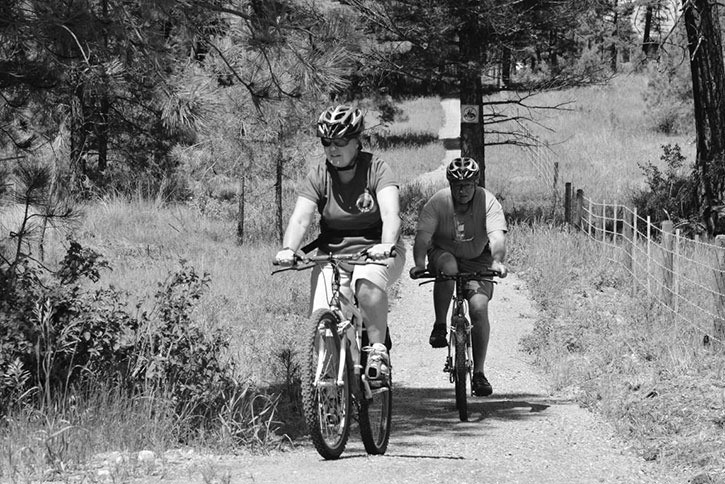Volunteers are working hard to improve the sections of the Trans Canada Trail through the Kootenay region as much as possible.
The Regional District of East Kootenay (RDEK) board of directors received a letter at its July 3rd meeting from the Trans Canada Trail Foundation, updating the board on its progress in the past year and mentioning the foundation goal having the trail fully connected across Canada by 2017.
“The key word there is connection, not completion. The objective for 2017 is not outright completion, but connection,” said Trails B.C. (the provincial partner organization for the federal Trans Canada Trail Foundation) Kootenay regional chair Al Skucas.
He added that “connection” in the Kootenay region means using forest service roads and other existing road infrastructure in the many parts of the region that do not have a designated section of the Trans Canada Trail.
“The Trans Canada Trail is an ongoing project that will take many years and it’s not feasible to make a separate trail right across the country without using roads in the interim,” said Skucas.
Much of the trail across southern B.C. is already completed, following the old routes of the Kettle Valley and the Columbia and Western railways, all the way from Hope in the Lower Mainland, across the Okanagan region, and across the Boundary region (around Grand Forks), before finally entering the Kootenay region and reaching Castlegar.
“Unfortunately, almost immediately after entering the Kootenay region, this contiguous 600-kilometre stretch of the Trans Canada peters out in Castlegar,” said Skucas.
But progress is being made, and just a month ago, Trail B.C. volunteers helped finish the gravel 70-kilometre Cranbrook-to-Wardner trail, which, when joined with the 25-kilometre paved North Star Rails to Trails linking Kimberly and Cranbrook (that gets 35,000 to 40,000 users each year), forms the only completed section of the Trans Canada Trail in the East Kootenay.
“There is still a lot of work to be done here, but there is a lot of stuff going on,” said Skucas, adding that the Cranbrook to Wardner trail took three years and more than $1 million to complete.
“It’s gravel, since we wanted a quality trail, not just a dirt mountain bike trail, so it took significant resources,” he said.
In terms of connectivity, the completed Trans Canada Trail that will one day run through the Kootenay region can already be easily cycled or hiked, using highways to get from Castlegar on to Nelson, and then the Grey Creek Pass forest service road to Kimberley.
After cruising the completed sections of trail between Kimberley and Wardner, cyclists and hikers would then be back to forest service roads all the way to the Alberta border.
“It (the Kootenay route of the Trans Canada Trail) is physically doable if you are happy to use roads. But as a true trail, it’s not that doable yet,” said Skucas, added the land on which the section from Wardner to Alberta would run is mostly privately owned by larger companies, such as Canfor, Tember and Teck, which in one sense is an obstacle, but in another is encouraging.
“Where there’s corporate land owners, there’s good opportunity to work out some kind of agreement for trail use. It’s where you have smaller private landowners that it can get tricky,” he said, adding much of the rest of the Trans Canada Trail is located on Crown land.
But larger corporate land owners don’t always equate to easy trail agreements, as Trails B.C. learned when it was unable to get the Cranbrook Wardner trail through a patch of land owned by CP Rail.
“They had no interest in allowing a trail there, so in that case we have no choice but to build the trail around their land,” said Mr. Skucas, adding that since the corporations and other private landowners tend to have land on the valley bottoms, this meant the volunteers ended up having to send the Cranbrook Wardner trail halfway up a hill.
“So we’re building in much more difficult terrain than what is ideal. It’s definitely an obstacle,” he said.
The Trans Canada was initially proposed as an idea in 1992 and work on it has been carried out by the foundation and local partner organizations ever since. While a single continuous trail across the country is still a long way off, there are many sections in place that users can hike, bike or even paddle.
The paddling sections (or blue trails) began in Ontario, where local trail volunteers figured canoe and kayak routes were a better approximation of traditional cross country “trails” than land-based trails.
B.C. now has its own “blue” section of the Trans Canada Trail — a canoe and kayak route stretching from Squamish to Howe Sound, complete with campsites along the way.
“The trail is whatever each local community decides it wants it to be,” said Skucas. “The whole idea of the trail is not just about having one trail across the country. That’s obviously a huge part of it, but it’s also about linking communities. So I’m watching what’s happening up in Invermere with the Columbia Greenways Trail Alliance and the Westside Legacy Trail, and from Fairmont Hot Springs to Canal Flats with the Spirit Trail, with great interest. Personally, in the future, I see a great opportunity to link up with those communities by trail (from Kimberley). Even up in Golden they are showing interest. This is long, long term but the opportunity is there.”
Skucas called the Westside Legacy trail an ambitious project and said much of the long-term success in linking the Upper Columbia Valley (and Golden beyond) to the Trans Canada Trail in Kimberley rests on the drive of local groups such as Greenways to see their individual projects through.
